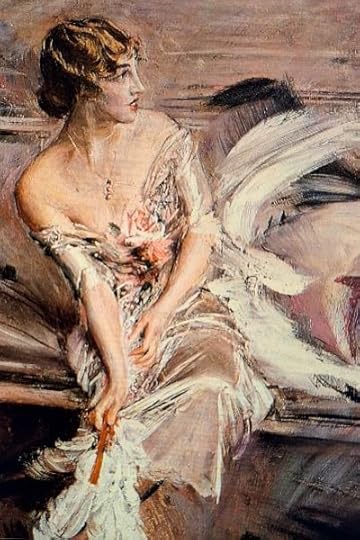The Sphinx
The Sphinx
And at yet another dinner she produced a revolver and placed it beside her. A startled guest enquired: ‘Duchess, what are you going to do with that?’ To which she replied: ‘Oh I don’t know, I might just shoot Marlborough!’ (excerpt from biography The Sphinx by Hugo Vickers).
Another relaxing evening at home at Blenheim Palace UK with the 9th Duke of Marlborough (Charles Richard John Spencer-Churchill) & his exquisite wife, the Duchess of Marlborough (Gladys Marie Spencer-Churchill).
Gladys Deacon was a French American born in 1881 in France to socialite Florence Baldwin and her husband Edward Parker Deacon. Florence was one of the acknowledged great beauties of her generation. Gladys mother was not an intelligent woman but she was extremely cultured. She was obsessed with high society and fashion but was also dedicated to the fine arts and supportive of artists.
A month after marrying Florence, Deacon knocked his wife down for the simple reason he didn’t like her hairstyle. Both of them had extra marital affairs. Deacon was frequently controlling, jealous and nasty. As he aged his temper became unmanageable and his actions increasingly bizarre.
While staying at the Hotel Windsor in Marseille, Deacon became increasingly suspicious of a young French attaché, Emile Francois Abeille, who’d befriended both he and his wife. Florence informed a socialite that Abeille liked to watch her swinging naked on a seat for his viewing pleasure.
After vacillating for weeks, Deacon cornered Abeille behind a hotel sofa and fired three shots at close range with his revolver. Abeille staggered to the passage and collapsed in a pool of blood. The French were known to be lenient towards crimes of passion. Subsequently he was imprisoned for only 12 months, acquitted of manslaughter but found guilty of intending to wound Abeille.
When Gladys was older, the indisputable fact her father had murdered her mother’s lover added to her notoriety. And after Deacon went insane and died in an insane asylum, many whispered it was obvious he’d passed his worst genetic traits onto his daughter Gladys.
Gladys Deacon, the sphinx in Hugo Vickers biography, made the fatal mistake at the age of 14 of becoming obsessed with the quest of marrying the 9th Duke of Marlborough. It didn’t bother her that the Duke had recently married American heiress Consuelo Vanderbilt. The Duke was busily spending Consuelo’s money feathering & renovating his nest, the spectacular historical Blenheim Palace in Oxfordshire England.
Gladys remained undaunted. A fortune teller had told her she would succeed in her quest and she was willing to wait it out. She managed to become the Duke’s mistress but didn’t succeed in bagging the Duke until 1921, when he married her and she was over 40 years old.
Gladys endured several miscarriages while slowly coming to the realisation that the Duke of Marlborough was a cad and a bounder. By rights his callous treatment of his first wife, Consuelo Vanderbilt should have put Gladys off her quest but it didn’t. Gladys had cunningly befriended them both and she was fully aware of the Duke’s shortcomings.
Author Hugo Vickers in his book The Sphinx, sought to understand why Gladys pursued such an unworthy man. Several distinguished gentlemen pleaded for her hand in marriage but she turned them all down. Gladys cheerfully claimed she’d slept with ‘every prime minister in Europe and many kings’.
So who was she? And why were her stocks so high? What made her so damned desirable?
Proust adored Glenys and wrote, ‘I never saw a girl with such beauty, such magnificent intelligence, such goodness and charm.’
She possessed an otherworldly beauty with a classical Greek profile (portrait above). Cheeky, clever and dedicated to fun, Gladys put her competitors in the shade with her sharp wit. It was a bonfire of the vanities for decades. Princes, statesmen, wealthy socialites, men who were handsomer and smarter than the Duke made fools of themselves trying to woo her.
Gladys became increasingly eccentric and enjoyed shocking high society by making outrageous claims and behaving badly. This endeared her to many notable men and women. Winston Churchill was a frequent guest at Blenheim Palace. At dull dinner and social gatherings Gladys played, teased, insulted and was frequently the most fascinating femme fatale in the room. She gleefully made enemies and they took revenge by spreading vicious rumours.
There was much speculation that Gladys was ruining her astonishing beauty when she opted for facial surgery. She had paraffin wax injected into her face, hoping to acquire what was known as a Grecian nose. The wax slid down to her chin and in her later years her jaw appeared somewhat swollen and heavier. One of her visitors claimed she had sat in front of an open fire, with her face turned away, until the wax softened and she could manipulate it back up to the bridge of her nose.
Realising the unsettling power of her eyes, Gladys arranged for a series of paintings of her startling blue-green eyes on the ceiling of Blenheim Palace’s portico. There were also sphinx sculptures in the gardens with faces closely resembling hers.
Unfortunately, Gladys and the Duke of Marlborough became estranged. She made no secret of keeping a revolver in her bedroom to stop him from entering. The palace became overrun with the pedigree dogs she was breeding and several rooms were made uninhabitable by numerous dogs running amuck and defecating.
Eventually the Duke threw her out of Blenheim Palace and sought a divorce. He did his best to humiliate her by locking her out of the palace. However, the Duke died before he obtained a divorce and she outlived him as The Dowager Duchess of Marlborough. The Marlborough heirs remained fond of her and continued to pay her an allowance.
Gladys moved to north Oxfordshire and later to a small farm. She eventually became a recluse surrounded by cats. By 1962, she was mentally ill but she lived to the age of 96 and died in 1977.
When Hugo Victors visited her shortly before she died, he noted Gladys had remained curious, witty and personable. She’d devoted herself to knowing what was going on in the world and recorded her witticisms and observations in diaries and notebooks.
Gladys had always been fully aware of the power of her gaze and her ability to render grown men speechless. Her tombstone is simple but elegant and etched into the stone is a stylized image of one of her lovely eyes. It’s a wide-open, all-knowing eye, similar to those on the ceilings at Blenheim Palace.
Image: Portrait of Gladys Deacon – future Duchess of Marlborough – by Boldini 1916.
The post The Sphinx appeared first on Lesley Truffle - Writer.




